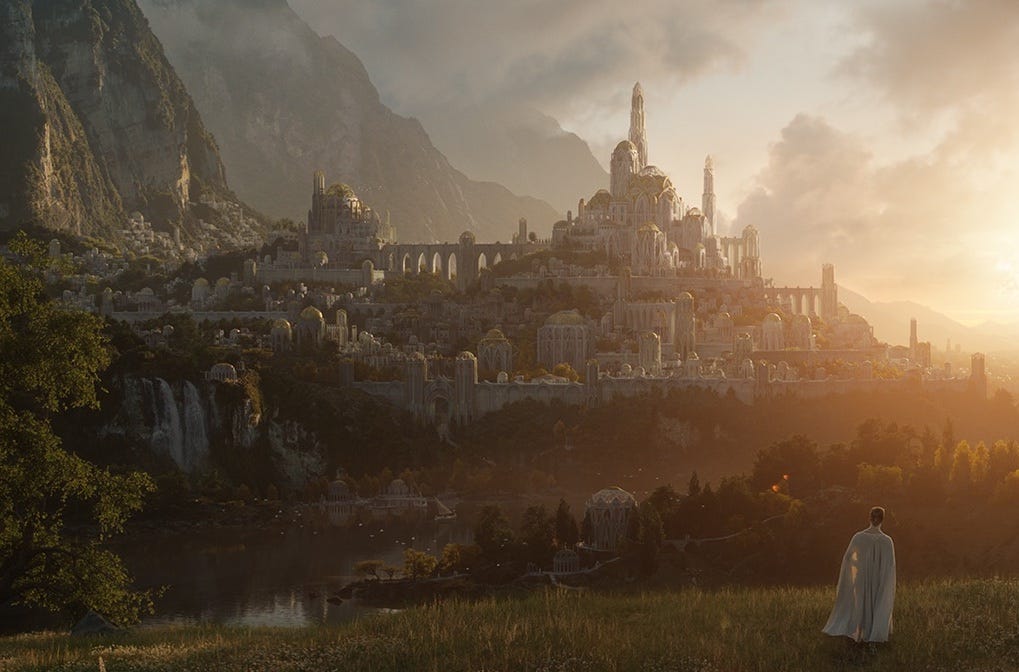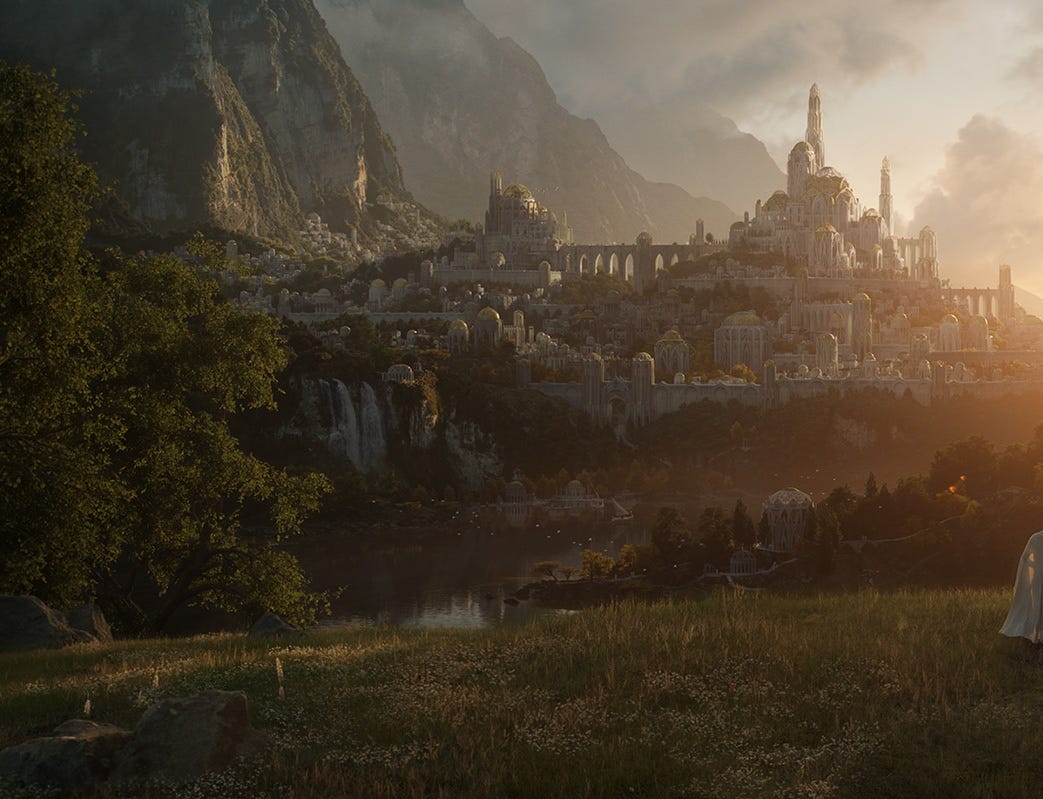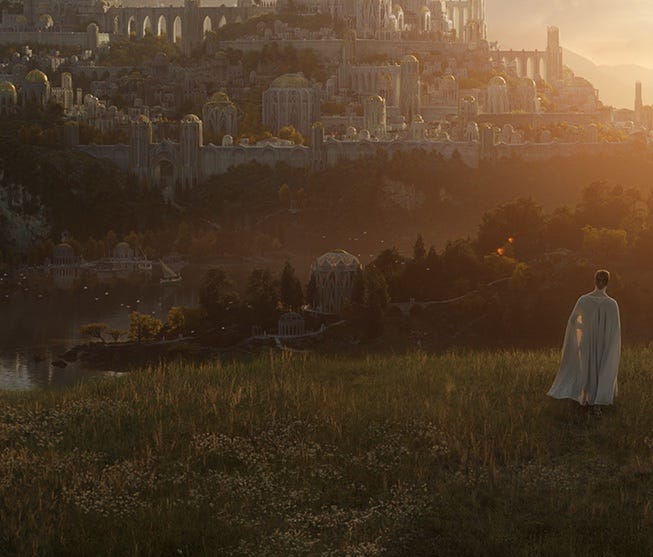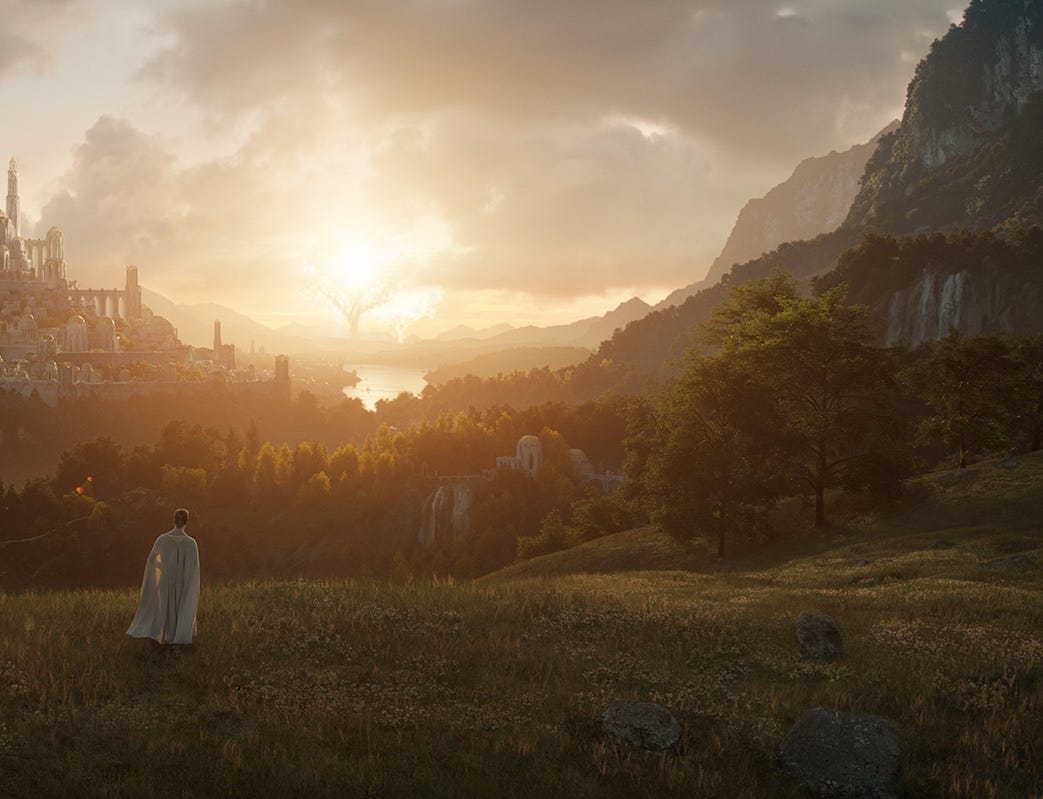Amazon's Amazing First LOTR Image
A vision of the Two Trees signals a new era in Tolkien's multiverse
It’s a stunning image. The sky is aflame with what looks like two atomic bursts. A city on a hill connected by an arched walkway to another citadel basks in the light. We’re looking through an opening between two mountainsides, waterfalls pouring down from cliffs. Birds fly along waterways and off domes. Ships float on surfaces that shimmer under the heavens. Standing on a lush green meadow, someone stares off into the distant horizon. And then your eyes perceive. It’s not two explosions, but giant trees, shining out from some long lost memory at the beginning of time — the spark at the heart of everything.
So arrives Amazon Studios’ first full bona fide image of their new Middle-earth. Inside its panorama is already the promise of an epic and even spiritual journey to the very core of J.R.R. Tolkien’s mythic multiverse. We’ve been busy journaling our first reading of the 12-volume History of Middle-Earth (THOME) as we go, making our way through part one of The Book of Lost Tales, the proto-narrative of Tolkien’s fabled Silmarillion; in its third chapter, we read Tolkien’s first imaginings of his Two Trees that burn with the power of Creation. So to my mind, Amazon’s creative team has chosen wisely to frame our perception in the deepest way possible, by opening our eyes to that “lost” but timeless vision.
The point of view is key. We are looking over the shoulder of a mysterious figure out into what unconsciously registers as a setting sun. But then our eyes also pick up the branches and trunk of a darker and a lighter tree. For those who know what the Two Trees are, a sudden joy explodes in the mind. For those who do not, there must be a kind of confusion and wonder. On the one hand, perhaps they might think they are looking at the mushroom cloud of a nuclear bomb? But then do nuclear bombs go off in Middle-earth? And the tops are blazing. There’s something strange and magical here, one cannot help feel.
Because the picture overall is beautiful and peaceful, it sustains our curiosity. Amazon’s original image file is letter-boxed (the current speculation is that it is in fact an image still from the first episode), giving it a cinematic context. This is an image that is meant to take over our vision. We can’t take it all in at once. We are meant to look closer and to scan it and be overwhelmed by it, and then sit back and ponder its meaning (I highly recommend downloading or expanding the image to contemplate its full grandeur and mysteries…)
My own first thought was, “My god, they are really going for it!” They are going to go cosmogonic with it. The great spans of space and time in Tolkien’s mythological universe, most readers and certainly filmgoers, don’t even quite comprehend, and here they are going to get a series that looks deep into the past, and as a result, far far into the future? That is fitting for the times we live in. Because we’re coming up on some epic changes in our world, and we need stories that ask us to think bigger and deeper thoughts with humility, and yes, with humanity.
It was only just two weeks ago that TheOneRing.net shared several important spy reports on the Amazon production — 20 fascinating details to be exact. Of that post, there were three that stood out to me as the most important:
The Tolkien Estate is “very happy” with the direction of the series so far, including its overall plan. This is *CONFIRMED*. This was put right at the top of the report, and rightfully so.
Apparently, because of this confidence, Amazon’s creative team has been granted the rights to parts of The Silmarillion and Unfinished Tales, which means they have enough material to give their series the needed backstory, heft and authenticity to tell an expansive epic, or multiple franchise stories.
Hobbits will be in the mix, and importantly, some will be “browner of skin,” as Tolkien describes the “Harfoot” hobbits himself in his Prologue to The Lord of the Rings. TheOneRing’s Clifford “Quickbeam” Broadway highlights this connection. The report that the Tolkien Estate is very happy with the production means they are behind this expansive humanist interpretation of Tolkien’s mythology. Also, we were told that Sir Lenny Henry, a British actor of more recent African descent — for we are all of African descent in one fashion or another — will play one of the “Harfoot” halflings. This is not “confirmed,” but Quickbeam comments on it with confidence.
We interviewed Quickbeam at great length in May, and touched on topics of diversity, and the potential rights of The Silmarillion. On the former, the decision to make this new series a multiracial and multicultural work is very exciting. It is our opinion that Tolkien’s South African heritage also makes this push for diversity especially poignant.
This inclusion of the world’s heritage also works hand-in-hand with the point about The Silmarillion. How so? Well, Tolkien’s mythology, while European in flavor and origin, is now essentially a world mythology. His books have been published in about 40 languages and have been sold across the globe. And yet most people don’t know The Silmarillion — his “Bible” of sorts — which tells the stories of the creation of the world and the long suffering saga of the Elves and humanity before our own recorded history. So this is new ground.
Of course, Amazon did release a series of images before this one: they were versions of Christopher Tolkien’s famous map of Middle-earth, refracted through the lens of the Second Age. This is fairly ironic, because Christopher Tolkien, who was J.R.R. Tolkien’s youngest son, was the fierce protector and executor of his father’s stories and legacy for many decades. With his passing early last year, speculation has increased around the idea that the Tolkien Estate is ready to relinquish some of that control, and hence, Amazon’s ambitious foray into Middle-earth, having received even the blessing to invent new tales.
But with these latest volleys from Amazon and TORN, it seems to me that some of the rumors about this new era has moved on from speculation. As Quickbeam and I discussed at length, it seems both the “Production” and the “Estate” must be on the same page concerning both the scope, scale and diversity of the series. This image confirms this with style and energy.
Take the images above and below, which focuses on the left side of the picture. What we are seeing is a grassy hill and a tree illuminated from afar, and a city beyond a water passage on another yonder hill. Fans and scholars are still debating what city this is but so far the consensus is that it is either Tirion or Valmar in Valinor, the land of the gods (the Valar). The city has many domes and walls, towers and spires, and bridges and walkways, reminiscent of Minas Tirith, yet different. Less warlike, and more at peace with itself, it is unmolested and majestic. The level of detail is awe-inspiring, and certainly of the caliber of Moria and Minas Tirith in Peter Jackson’s Lord of the Rings.

There is a lot of Jackson’s Minas Tirith and Rivendell in here, which were both mostly designed by the renowned Tolkien artists Alan Lee and John Howe. But I also can see the influence of the other great Tolkien artist Ted Nasmith here. It has his hyper detail and his delight in light: the birds or seagulls flying over the waterway and the trees, the way the light catches the leaves and the grass blades and the flowers on the hill, the fine grain on the rocks here and there; the rolling hidden surprises tucked in this corner and that bend. But Amazon is also bringing their own unique vibe to this image, both in the bold choice to capture the Two Trees in a way that I predict will become iconic, and in the way they added a couple subtle lens flares off the left shoulder of the character, as well as a diaphanous glow in her cloak, the cut of her arm giving her a noble air.
Tirion was built by the Vanyar and the Noldor, two of the three great tribes of Elves who migrated to the holy land of the Valar over the great sea of Belegaer, far to the west of Middle-earth where the events of The Lord of the Rings take place. In The Silmarillion, we learn about the creation and founding of Valinor by the Valar, who invite the Vanyar, the Noldor, and later, the Teleri, to come live in the Blessed Realm, where also shine two great trees, one golden, and one silver, named Laurelin and Telperion. These trees are filled with the sap and light of the universe (we explored their genesis at great length here).

Tirion sits on a great hill in the Calacirya, a narrow opening in the mighty mountain range known as the Pelóri, the Mountains of Valinor. The Vanyar are the most pious of the Elves and later decide to live closer at the base to the great peak of Taniquetil, where the lord and queen of the Valar live high above near its summit. But behind us and the vantage of this image is the sea. It could be the figure is standing a bit up the coastline or even on the island of Tol Eressëa with Tirion on the hill of Túna rising before us.
This could be a clue as to who the person is who is standing in the foreground. We will get to that more later. Suffice to say for now, that a different tribe of Elves, the Teleri, reside in Tol Eressëa, and are known for their ships and connection with the sea. Their main home is the harbor city of Alqualondë. It could be the domes we see on the near side of the image just below the onlooker to the left and the right, are part of Alqualondë, though it is more likely they are just outposts of either Tirion or Alqualondë, with pathways leading between the two.
Also known as the Falmari, the Elves of Alqualondë, are a key connection back to the Elves who remained in Middle-earth and resisted the call of the Valar to join them in Valinor. One figure in particular connects several threads and ages of Tolkien’s great myth cycle — Galadriel, the Lady of the Golden Wood, ally of Gandalf and one of Frodo’s great mentors. She is the daughter of Finarfin and Eärwen, a prince of the Noldor and a princess of the Falmari respectively.
Later when Galadriel leaves Valinor for Middle-earth and is hence exiled, she reunites with her great-uncle, Elu Thingol, the greatest elven king among the Teleri Elves who stayed behind in Middle-earth. His people are called the Grey Elves, or Sindar. Like their kin in Valinor who have a great affinity with nature through the sea, the Grey Elves are also close to nature, but have a great affinity not just for the sea, but also the woods. And so Galadriel becomes a great mistress of the forests of Middle-earth, and it is with the Grey Elves that she later mostly attaches her fate and witnesses “Three Ages of the Sun.”
Which brings us back to the Noldor. Who are they? The Noldor are known as the Deep Elves. They crave and cultivate great knowledge and skills of the hand and mind. Fëanor is the most gifted of the Noldor and creates the Silmarils, three jewels that capture the light of the Two Trees. He is also a cousin of Galadriel.
Fëanor and his Silmarils set a number of key events in motion that lead to the exodus of the Noldor from Valinor back to Middle-earth, where war is waged against the god Morgoth, the Great Enemy, liar, and corrupter of the ancient world. Balrogs are Morgoth’s lieutenants. Dragons are his brood. Orcs are his slaves. Sauron is his pupil and apprentice. He kills the Two Trees.

So Galadriel, we believe, stands here looking out on the world when it was at its height of beauty and divine grace — an age when Two Trees lit the world, and before they died, and their two last fruits became the sun and moon. Some fans disagree with this assessment, but I am fairly confident, since early press availability has focused on Morfydd Clark, who will play young Galadriel.
While the figure in the foreground doesn’t appear to have the famous golden hair of Galadriel, I would argue that is because the back of her head is in shadow with the glow of the Two Trees illuminating the rim of her head with light. She is also wearing a white gown of sorts, which is often associated with Galadriel. Nerd of the Rings is of similar mind. You can catch his analysis of the image here. Some fans have hypothesized that it could be the great mariner Eärendil. But as is pointed out by Nerd of the Rings, he was born after the Two Trees died.
I think we can confidently predict this is the White Lady; the other plausible theory out there is that it is Finrod Felagund, Galadriel’s brother. It is very likely a flashback or extended prologue, giving us background on the history of Middle-earth and her own place in a long struggle against Morgoth and Sauron, going all the way back to her youth in Valinor. It also will set the stage for the Second Age, when the people of Númenor frequently keep a maritime connection to the Elves of Eldamar, the coastal region of Valinor where the Teleri, Noldor and Vanyar mostly live and preserve their ancient culture.
This is important for a number of reasons. It will give the series depth and a larger cosmic context. But perhaps most importantly, it indicates that the creative team at Amazon is steeped in The Silmarillion, which can only be a good thing. Finally, by taking us back to the era of the Two Trees, they have opened the door to an adaptation of The Silmarillion, if all goes well. The implications are immense. Looking at this image, we can almost see such a future right now.







